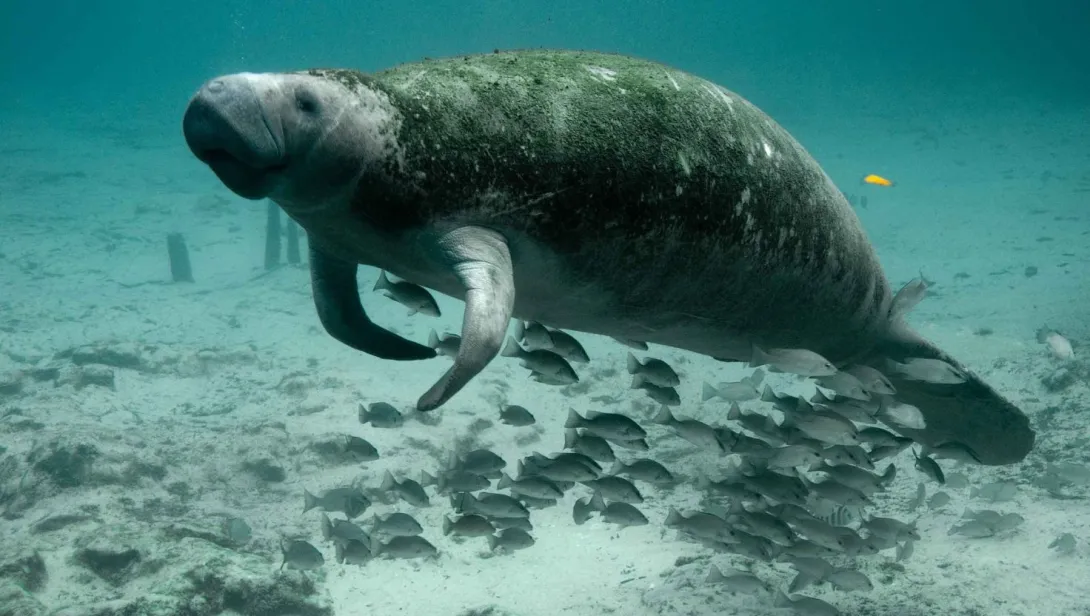Skip to main content
Introduction
- The Manatee is a large, aquatic mammal belonging to the order Sirenia, often referred to as "sea cows".
- They are known for their gentle nature, slow movements, and herbivorous diet.
- Manatees are found in warm, shallow coastal waters, rivers, and estuaries in the Americas and West Africa.
Physical Characteristics
- Manatees have a large, rounded body, with lengths ranging from 8 to 13 feet (2.4 to 4 meters) and weights up to 1,300 pounds (590 kg).
- Their skin is thick and wrinkled, usually gray or brown, and often covered with algae.
- They have paddle-like flippers for steering and a flat, rounded tail for propulsion.
- Manatees have small eyes and no external ears, but they have excellent hearing and can detect low-frequency sounds.
Habitat and Distribution
- Manatees are found in warm, shallow coastal waters, rivers, and estuaries in the Americas and West Africa.
- They inhabit regions such as the Caribbean, Gulf of Mexico, Amazon Basin, and West African coast.
- Manatees prefer water temperatures above 68°F (20°C) and migrate to warmer waters during colder months.
Diet and Foraging
- Manatees are herbivorous, feeding primarily on seagrasses, algae, and aquatic plants.
- They consume up to 10% to 15% of their body weight in vegetation daily, which can amount to over 100 pounds (45 kg).
- Manatees use their prehensile lips to grasp and pull plants into their mouths.
- They are slow feeders, spending up to 8 hours a day grazing.
Behavior and Communication
- Manatees are solitary or live in small groups, though they may gather in larger numbers in warm water refuges.
- They communicate through vocalizations such as squeaks, chirps, and whistles, as well as through body language.
- Manatees are slow swimmers, typically moving at speeds of 3 to 5 mph (5 to 8 km/h) but can reach up to 20 mph (32 km/h) in short bursts.
- They are curious and gentle, often interacting with humans and boats in the wild.
Reproduction and Lifespan
- Female Manatees give birth to one calf after a gestation period of about 12 to 14 months.
- Calves are born weighing around 60 to 70 pounds (27 to 32 kg) and are 3 to 4 feet (0.9 to 1.2 meters) long.
- Calves nurse for 1 to 2 years but may stay with their mothers for up to 2 years.
- Manatees have a lifespan of 40 to 60 years in the wild, depending on environmental factors.
Conservation Status
- Manatees are classified as Vulnerable on the IUCN Red List, with populations threatened by human activities.
- They are protected under laws such as the U.S. Endangered Species Act and the Marine Mammal Protection Act.
- Conservation efforts include protected areas, speed zones for boats, and public awareness campaigns.
Unique Adaptations
- Manatees have low metabolic rates, allowing them to survive on a diet of low-nutrient vegetation.
- Their thick skin and blubber help them regulate body temperature in warm waters.
- They have continuously growing molars that replace worn teeth, adapted for grinding tough vegetation.
- Manatees can hold their breath for up to 20 minutes but typically surface every 3 to 5 minutes to breathe.
Cultural Significance
- Manatees are revered in many cultures as symbols of peace, gentleness, and environmental conservation.
- They are featured in folklore, literature, and art, often representing harmony with nature.
- In some cultures, Manatees are considered spiritual guides and protectors of the waterways.
Fun Facts
- Manatees are closely related to elephants, sharing a common ancestor from millions of years ago.
- They have no natural predators, but human activities pose the greatest threat to their survival.
- Manatees are slow breeders, with females giving birth to a calf only once every 2 to 5 years.
- They are keystone species, playing a crucial role in maintaining the health of aquatic ecosystems by grazing on vegetation.
- Manatees have been known to interact with humans in the wild, often approaching boats and swimmers out of curiosity.
- They are excellent swimmers, using their powerful tails to propel themselves through the water.
Threats to Manatees
- Boat strikes are a leading cause of injury and death for Manatees, especially in areas with heavy boat traffic.
- Habitat loss due to coastal development and pollution reduces their access to food and warm water refuges.
- Cold stress can be fatal for Manatees, as they require warm water to survive.
- Red tide (harmful algal blooms) can poison Manatees and their food sources.
Conservation Efforts
- Protected areas and sanctuaries have been established to safeguard Manatee habitats.
- Speed zones for boats help reduce the risk of collisions with Manatees.
- Rescue and rehabilitation programs provide care for injured or sick Manatees, with the goal of releasing them back into the wild.
- Public awareness campaigns educate people about the importance of Manatee conservation and how to coexist with these gentle giants.
